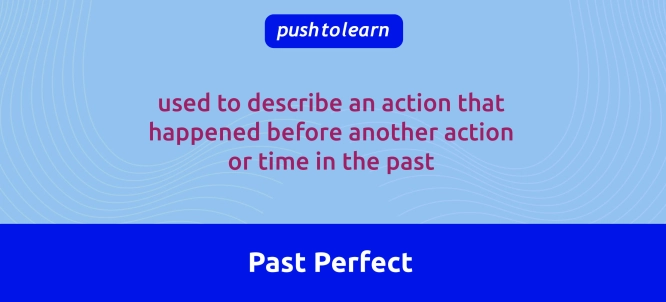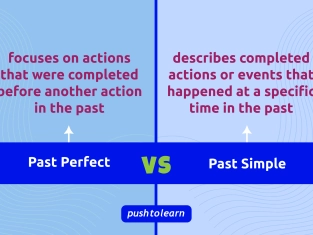by PushtoLearn
Past Perfect
Table of Contents
Past Perfect – Exercises
These exercises focus on Past Perfect
What is the Past Perfect Tense?
The past perfect tense is used to describe an action that happened before another action or time in the past. Think of it as the "past of the past."
For example:
-
I had eaten breakfast before I went to school.
Here, the action "had eaten" happened before "went to school."

How to Form the Past Perfect
The past perfect is made with two parts:
-
Had (the helping verb)
-
Past participle (the third form of a verb)
|
Verb |
Past Participle |
|
eat |
eaten |
|
go |
gone |
|
play |
played |
|
study |
studied |
Example Sentences:
-
I had finished my homework before my friends arrived.
-
They had left by the time we reached the station.
Rules for Using Past Perfect
1. Show an earlier action
Use the past perfect to show which action happened first.
-
She had called him before he arrived.
(Action 1: She called; Action 2: He arrived.)
2. Common with time expressions
Words like "before," "after," "by the time," and "already" are often used.
-
By the time the movie started, we had bought popcorn.
-
I had already studied when the test began.
3. With reported speech
When reporting what someone said, the past perfect shows an earlier event.
-
He said he had seen the movie before.
Common Errors and How to Avoid Them
|
Mistake |
Correct Sentence |
Explanation |
|
I had went to the park. |
I had gone to the park. |
Use the past participle, not the past tense. |
|
She didn’t had time to finish. |
She didn’t have time to finish. |
After "did/didn't," use the base verb. |
|
They left before we had arrived. |
They had left before we arrived. |
Use past perfect for the first action. |
Everyday Uses of Past Perfect
-
Talking about plans or actions in the past:
-
I had hoped to visit Paris, but I couldn’t.
-
Telling stories:
-
After they had set up the tent, it started raining.
-
Explaining changes:
-
She had never driven before taking lessons.
Quick Comparison: Past Perfect vs. Past Simple
|
Past Perfect |
|
|
Describes one past action. |
Describes an action before another. |
|
I finished my work. |
I had finished my work when she arrived. |
FAQ
What is the main use of past perfect?
It shows which action happened first in the past.
What is the structure of past perfect?
Use had + past participle (e.g., had eaten, had gone).
Can I use past perfect without a second action?
Yes, sometimes context shows the second action. Example: I had never been to London before 2020.
What’s the difference between past perfect and present perfect?
-
Past Perfect: Action happened before another past action.
-
Present Perfect: Action happened in the past but affects now.
Do I always need “before” or “after” with past perfect?
No, but they help clarify the sequence of actions. Example: She had left the party early.

